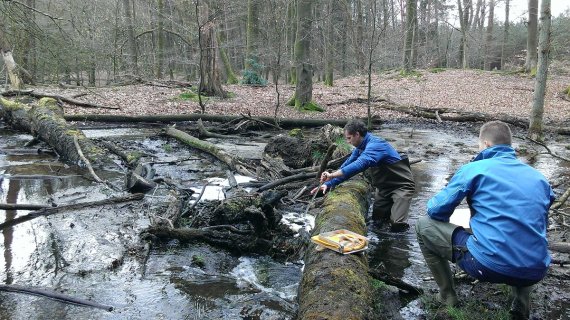At various spots along the eight kilometer-long Hierdense Beek, flood plains have been created by putting trees in the water. A total of 70 ‘wood packages’ have been placed across the stream. At seven locations ‘sand motors’ have been created too, each one made of 200 cubic metres of sand. The fast-flowing water carries away the sand, which then gets caught by the trees in the stream. As a result the stream becomes shallower and overflows its banks. This works. ‘At peak flow times there are already 60 hectares under water around the stream,’ says project leader Maarten Veldhuis of the water board. That is good for the flora and fauna and for the biodiversity of the stream.
‘Precisely that transition from wet to dry is important,’ explains ecologist Ralf Verdonschot of Alterra. ‘Grasses, sedge and yellow irises, which are highly nutritious for mammals, grow in a green, swampy belt around the stream. It is a sea of flowers here in the summer. A floodplain like this creates a biodiversity hotspot.’ This method is called ‘Building with nature’: creating the right conditions and then letting nature take its course.
This was sorely needed in the Hierdense Beek, explains Veldhuis, because the stream was flowing far too fast. ‘In the past the runoff into the stream was slowed down by lots of heather, swamp, peat and woodland. This mean rainwater only reached the stream slowly.’ The environment around the stream worked like a sponge, adds Verdonschot. But the intensification of agriculture changed that. A lot of new ditches were added as land was brought under cultivation, resulting in water draining from the area at a much faster rate. ‘The stream rushed towards the Veluwe lake,’ says Verdonschot. ‘As a consequence the stream dug itself deeper and deeper into the landscape. And the water took all sorts of stuff with it – substratum, leaves, gravel, leaving bare banks behind it.’
 It is precisely that substratum, says Verdonschot, which is crucial for numerous species. ‘For water insects such as sedge flies and mayflies, for fish such as the brook lamprey, and to provide a bank for birds such as the kingfisher. To keep that substratum in place, the soil needs stability. Flooding helps create that.’ With the help of Wageningen expertise the stream has been restored to its former glory. Which is not as easy as it might look, explains extraordinary professor Piet Verdonschot (Ralf’s father)
It is precisely that substratum, says Verdonschot, which is crucial for numerous species. ‘For water insects such as sedge flies and mayflies, for fish such as the brook lamprey, and to provide a bank for birds such as the kingfisher. To keep that substratum in place, the soil needs stability. Flooding helps create that.’ With the help of Wageningen expertise the stream has been restored to its former glory. Which is not as easy as it might look, explains extraordinary professor Piet Verdonschot (Ralf’s father)
. ‘You must position those wood packages where they won’t totally block up the stream. It took us two years to figure that out. The way those trees are lying might look random, but that’s deceptive.’
The job is not done, either. The researchers will be using the next few years to analyse the effects, says the professor. ‘How high does the water level go, how much sand is carried downstream, and what happens in that gradient between dry and wet? You need several years to get a clear picture of all that. If you want to duplicate this pilot elsewhere, you need to know exactly what the effects are, including the impact on water safety downstream and on the water supply.’
Besides the chance to apply knowledge in the field, the collaboration with the Vallei en Veluwe water board provides Wageningen with internship opportunities for students. Staff of the water board can take courses in Wageningen. Professor Piet Verdonschot hopes to make similar deals with three other water boards in the region around Wageningen.


